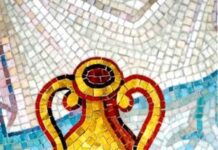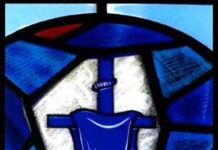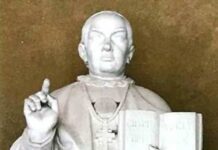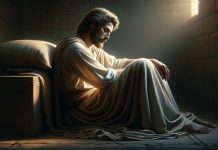You are not signed in as a Premium user; we rely on Premium users to support our news reporting.
Sign in or Sign up today!
The decision of the Grand Master of the Equestrian Order of the Knights of the Holy Sepulchre to abolish the use of the sword in the ceremony of investiture of a knight was a tolling bell for the end of a last remnant of Catholic chivalry in the world.

passage ceremonies conferring knighthood
during the Middle Ages
All true knights of the Holy Sepulchre, spiritual descendants of the Crusaders who defended the Holy Land, are in mourning.
Were the knights consulted about their opinion? Were the ladies consulted if they wanted to see the men no longer receiving the touch of a sword on their shoulders? Did the young men who aspire to knighthood agree to be “knighted” just as the women?
When the spirit of chivalry is dead among Catholics, the sacrament of confirmation loses its grip on souls. Cowardice reigns.
Loss in Historical Context
For us to understand the gravity of the loss — certainly to all true knights who have mourned the removal of the sword — let us see what a knight was like in medieval times.
Below is an excerpt from a study I have on medieval chivalry, which I use in retreats for men:
It was the end of the battle. Everywhere, the strewn bodies of the Crusaders were covered with blood. They testified to their fidelity, to their ideal and unfortunately, to their defeat. The Moslems had won in the Battle of Tibiriadis and the main Christian leaders, and even the King of Jerusalem, had become prisoners of Saladin.
Only one man carried on fighting.
Covered with iron and blood, mounted upon a horse that was both exhausted and foaming, surrounded by Turks, he was the last knight who resisted. He brandished his sword in the air with incredible agility, and the bodies of the infidels who had dared to come too close to him piled up around him.
The Turks contemplated him from far away, and in the fury of their gaze, there was also, in spite of everything, a spark of admiration. Who was this Christian man who did not surrender? What kind of man was that who’d never give up? Who’d not step back? Who’d not retreat? What mother had given birth to a son of such magnitude? Who had forged this soul that was like a suit of armor and this indomitable heart?
Wounded and bloodless, both knight and steed fell to the ground, the enemies surrounding him. Everything came to an end.
Everything? No.
The admiration did not end. The death of the hero made the admiration grow still. And the Turks, the semi-barbarians, the Moslems, the enemies, approached the dead knight and touched the tips of their capes to the blood of the Crusader to keep with them something of a souvenir of the most valiant of men.
Who was that man of an iron heart? Which mother had conceived and given birth to such a hero?
He was a son of the Catholic Church. He was a knight.
This happened in the times of the Crusades, in the time when there was faith on earth — times when people would follow the counsel of Christ when He said, “Now he who does not have a sword, let him sell his mantle, and buy one.” (Luke 22:46)
Forward to 6:50 to see the practice of using a sword as part of investiture
This happened in the centuries of faith and of glory, in the centuries of Chivalry — an army of men, standards floating to the winds of glory, rushing upon the infidels in a cavalcade of faith and of heroism.
Chivalry: A Saint-Making Force
In the Middle Ages, chivalry was the Christian form of the military condition, and the knight was the Christian soldier in his fullness. Much more than an institution, chivalry was an ideal of the military life. It was by the means of chivalry that the Church transformed barbarians into saints.
You can understand the value of this institution when you consider:
- St. Louis, king of France
- St. Ferdinand, king of Castile
- St. Nuno Álvares Pereira, constable of Portugal
- St. Joan of Arc
They were some of the saints generated by the Church by means of chivalry. And because of this, chivalry was admired even by the infidels.

In spite of all the defects that are known to us, medieval chivalry gave to the Church a collection of saints, men and women like no other social class has ever given, precisely because they were a true social elite, and holiness was multiplied in them by heroism — by the consecration of the magnificent energies they had.
It suffices to evoke the saints, kings and queens since the 12th century; there have never been so many saints among the heads of state in a state known as Catholicism.
Moreover, the missionary vocation of so many young Europeans — in the sense of foreign missionaries going to pagan lands; they derive their mission, their enthusiasm, from the spirit of chivalry.
Chivalry Manifest
So, the knights were the vassals of God and soldiers of the Faith. For them, Our Lady was their Dame, the lady whom they had to serve as the vassal served the lady of his castle. This relationship with God and Our Lady and the knights was so alive, the way they referred to God was so real that it sometimes caused confusion.
When St. Joan of Arc presented herself to the captain Robert de Baudricourt, asking him to give her soldiers to help save France, she left him confused when she said to him, “France does not belong to the sire of England, nor to the sire of France, but to my Sire.” And the captain was amazed because there were already two kings disputing the throne of France, and now she comes with the potential of a third. He asks, “Who is your sire?” and she replied with that candor of innocence, “Mon Sire est Dieu” (My king is God).
St. Theresa of Ávila referred to Our Lord Jesus Christ, as “Your Majesty,” because, for her, He was her living king.
The Code of Chivalry has never been written; the historians have deduced it by examining the lives of the knights. It consisted of Ten Commandments every knight had to respect to be worthy of his title.
Permit that Thy servant here present may … never make use of this sword or another to injure anyone unjustly, but he may use it always to defend justice and right.
The knighthood ceremonial prayer, uttered by the bishop or the lord as he invested the new knight by touching his shoulders with the sword, asks:
Most Holy Lord, Father Almighty, Thou Who didst permit the use of the sword on earth to combat the perfidy of the evil ones and to defend justice, and wants to establish the order of chivalry for the protection of the people, permit that Thy servant here present may dispose his heart to do good and never make use of this sword or another to injure anyone unjustly, but he may use it always to defend justice and right.
The knights exalted during Holy Mass repeated the choirs of the heavenly militias: “Sanctus, Sanctus, Sanctus, Dominus Deus exercituum!” (Holy, Holy, Holy, the Lord God of Armies!)
Because they had faith.
Catholic Spiritedness Dying?
The last remnant of that great Catholic spiritedness has just been buried by the new orientation of the Equestrian Order of the Holy Sepulchre of Jerusalem — aimed to reflect the views of the pope. Equality between men and women is the new “woke” paradigm.
All true Catholic women want their husbands, sons and brothers to be real Catholic men — leaders marked by Christian courage, who are prepared to sacrifice themselves to defend those whom they love, the Church, country and family — not snowflakes who fear brandishing the sword.
Raymond de Souza, KHS, KM gives retreats on the spirit of Chivalry to men interested in serving the Truth in a masculine, Catholic way.
— Campaign 32075 —
Have a news tip? Submit news to our tip line.

We rely on you to support our news reporting. Please donate today.























